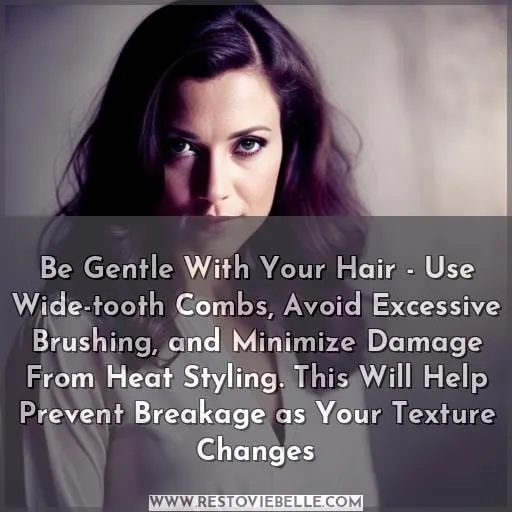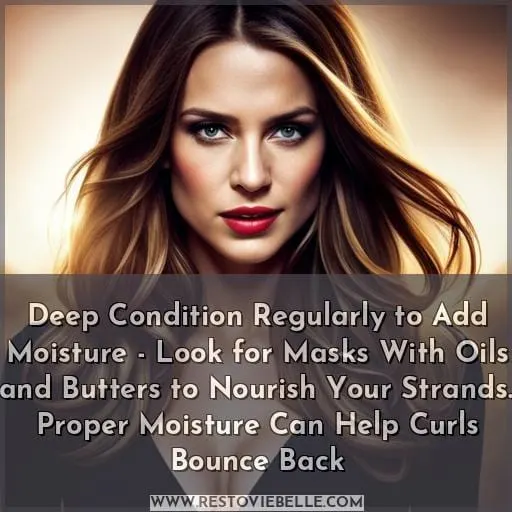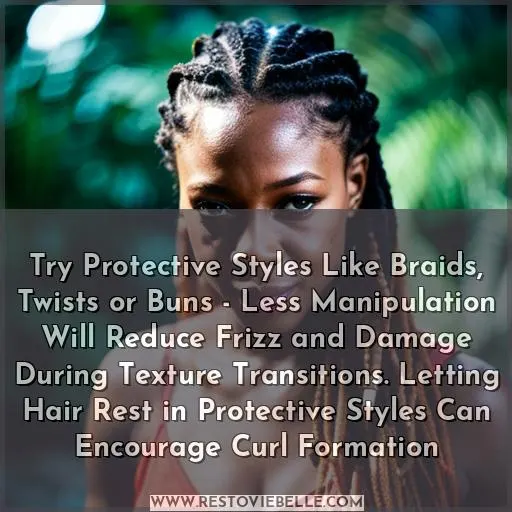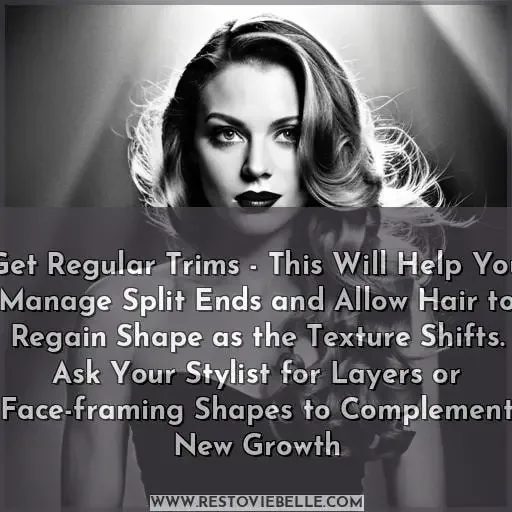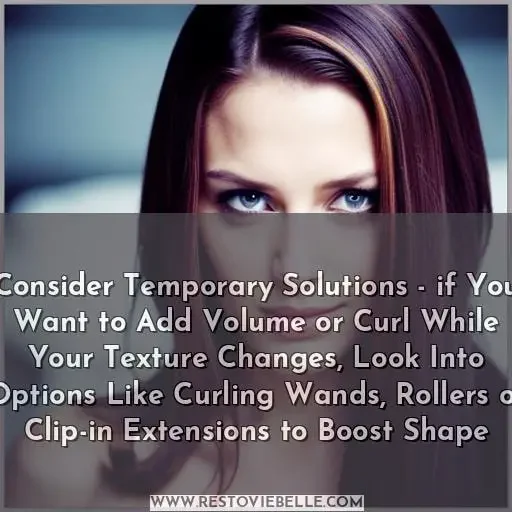This site is supported by our readers. We may earn a commission, at no cost to you, if you purchase through links.
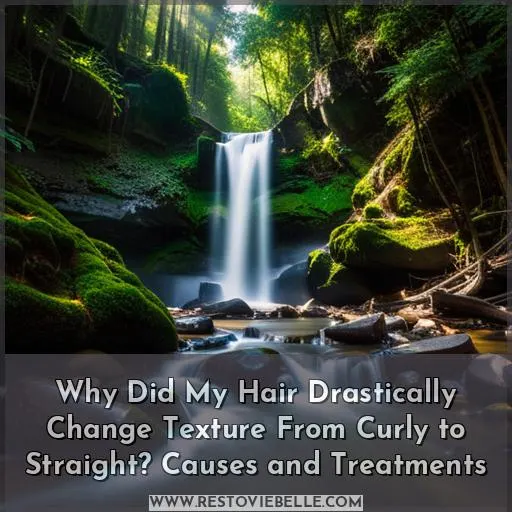
One day your straight strands just decided enough was enough, packed their bags and headed for Curlsville! But don’t despair.
All those creams and products you used to tame your hair? Toss ’em. Your new curly ‘do needs moisture and hold, not heaviness.
Don’t overwash or overbrush either. Treat your curls gently by shampooing less and using a wide tooth comb.
Your hair’s texture may have changed, but with a little TLC, you’ll see your new bouncy, beautiful curls were there all along – just waiting to make their grand entrance!
Table Of Contents
- Key Takeaways
- Be Gentle With Your Hair – Use Wide-tooth Combs, Avoid Excessive Brushing, and Minimize Damage From Heat Styling. This Will Help Prevent Breakage as Your Texture Changes
- Deep Condition Regularly to Add Moisture – Look for Masks With Oils and Butters to Nourish Your Strands. Proper Moisture Can Help Curls Bounce Back
- Try Protective Styles Like Braids, Twists or Buns – Less Manipulation Will Reduce Frizz and Damage During Texture Transitions. Letting Hair Rest in Protective Styles Can Encourage Curl Formation
- Update Your Products as Needed – if Your Hair is Straighter, Look for Products Designed for Straight or Wavy Hair Rather Than Curly. You May Need Lighter Creams or Less Intensive Stylers
- Get Regular Trims – This Will Help You Manage Split Ends and Allow Hair to Regain Shape as the Texture Shifts. Ask Your Stylist for Layers or Face-framing Shapes to Complement New Growth
- Consider Temporary Solutions – if You Want to Add Volume or Curl While Your Texture Changes, Look Into Options Like Curling Wands, Rollers or Clip-in Extensions to Boost Shape
- Embrace the Change – Hair Texture Isn’t Set in Stone. Find New Styling Techniques and Products That Work With Your Hair’s Current Needs. Temporary Changes Can Let You Have Fun With New Styles!
- Conclusion
Key Takeaways
- Hormonal fluctuations during puberty or menopause can alter hair texture.
- Heat styling damage from flat irons and blowdryers can cause curl pattern changes over time.
- Genetics influence the shape of the hair follicle, which impacts curl pattern.
- Avoiding excessive heat styling and embracing temporary styling changes can help one adapt to new hair textures.
Be Gentle With Your Hair – Use Wide-tooth Combs, Avoid Excessive Brushing, and Minimize Damage From Heat Styling. This Will Help Prevent Breakage as Your Texture Changes
Don’t brush it to death, baby. Go easy on that mane with a wide-tooth comb and lower heat – you’ll keep those curls poppin’ as they transition.
As your hair texture changes from curly to straight, it’s vital to be gentle and minimize damage. Reach for a wide-tooth comb rather than a narrow brush to gently detangle those coils without yanking. Limit brushing to when your hair is conditioned in the shower for slippery strands.
Heat styling can frazzle curls over time, so allow your hair to air dry when possible or diffuse on a lower setting.
With a delicate touch, you’ll keep your hair looking healthy and bouncy during this transitional phase. Adapt your routine to nurture those curls, preventing breakage as the texture evolves.
Deep Condition Regularly to Add Moisture – Look for Masks With Oils and Butters to Nourish Your Strands. Proper Moisture Can Help Curls Bounce Back
Condition yourself deeply to nourish your soul’s curls, transforming tangles into effortless waves of self-love. When hair texture changes from curly to straight, it’s crucial to add moisture back in. Regularly using hydrating hair masks can revive limp strands by infusing nourishing oils and butters.
Look for formulas with ingredients like coconut oil, shea butter, and avocado oil to replenish moisture balance.
Applying masks from roots to ends, letting them soak for 10-15 minutes before rinsing, provides intense hydration.
By deep conditioning with moisture-rich masks weekly, you’ll notice your hair regaining its bounce and shine.
Try Protective Styles Like Braids, Twists or Buns – Less Manipulation Will Reduce Frizz and Damage During Texture Transitions. Letting Hair Rest in Protective Styles Can Encourage Curl Formation
Try braiding or twisting your hair to protect it and reduce damage while the texture changes.
- Put your hair in braids, twists, or buns to reduce manipulation and friction.
- Letting your hair rest in protective styles can encourage curl formation.
- Reduce heat styling while the texture transitions to prevent further damage.
- Opt for loose styles without tugging to prevent pulling out curl patterns.
- Use satin scrunchies, soft headbands, and lined caps for low-friction accessories.
Protective hairstyles like braids and twists let your hair rest while reducing frizz and damage during texture transitions.
Update Your Products as Needed – if Your Hair is Straighter, Look for Products Designed for Straight or Wavy Hair Rather Than Curly. You May Need Lighter Creams or Less Intensive Stylers
You’ll need lighter creams and less intensive stylers if your hair is straighter; if curlier, try heavier conditioners and curl-defining creams.
With straighter strands, look for lightweight leave-ins, oils, and styling creams for straight or wavy hair. These provide nourishment without weighing hair down. If curlier, use thick curl creams, custards, or gels that intensely define curls and reduce frizz.
Avoid heavy products like shea butter or oils if your texture is straightening. They may leave buildup and make hair limp.
Stay observant of curl pattern changes, and be willing to switch products so they complement the new texture. The right formulas will nourish strands and enhance natural beauty as hair evolves.
Get Regular Trims – This Will Help You Manage Split Ends and Allow Hair to Regain Shape as the Texture Shifts. Ask Your Stylist for Layers or Face-framing Shapes to Complement New Growth
Tis the season for fresh trims! Ask your stylist for some new face-framing layers to help rock your new texture. As hair texture goes from curly to straight, regular trims become essential for managing the transition and keeping split ends away.
Discuss options like long layers, bangs, or face-framing highlights with your stylist.
Get a trim every 6-8 weeks to remove splits and allow new growth to take shape. Go for angled cuts, piece-y layers around your face, shoulder-length cuts with movement. Avoid blunt, severe lines. Get creative! Style short side-swept bangs, add lots of layers, try a chin-length bob.
Work with your stylist to find the perfect cut and products to embrace your hair’s exciting metamorphosis.
Consider Temporary Solutions – if You Want to Add Volume or Curl While Your Texture Changes, Look Into Options Like Curling Wands, Rollers or Clip-in Extensions to Boost Shape
As an individual, you may notice your naturally curly hair gradually straightening over time. While the exact reasons are unclear, this texture change could stem from hormonal fluctuations, damage from heat styling, or the natural aging process affecting your hair follicles.
To temporarily boost curls as your hair transitions, consider using curling wands, rollers, or clip-in extensions to add volume and shape without further damaging your hair.
Curling Wands Add Volume
Get some bouncy curls going with curling wands if your hair’s gone flat. As your tresses transform, heat from wands molds temporary texture by reshaping the hair structure within each follicle. Yet beware of overusing hot tools – excessive heat damages hair, worsening texture changes.
Instead, reach for curling wands and rollers only when needing extra oomph between trims. With smart styling techniques and product selections, you can complement natural hair shifts while avoiding harm.
– Hair Rollers Boost Curls
Enjoy those bouncy ringlets as rollers temporarily reshape your hair’s texture. Seeking heat-free curls? Sleep in rollers overnight for a textural transformation without frying follicles. Your genes dictate follicle shape, but rollers enhance natural curl through tension.
Explore myriads of roller techniques for styling options, from large Velcro to tiny magnetic ones. Creatively curling each section boosts volume or tames frizz without damage. While rollers temporarily transform hair, they cannot permanently alter genetic hair texture.
– Clip-In Extensions For Shape
Attach clip-in extensions for extra curve and contours. Human hair extensions blend seamlessly with your natural texture, adding bounce and body without obvious attachments. Carefully match your shade and curl pattern, then style as usual. Clip-ins allow you to experiment with lengths and volume as your hair transforms, embracing each phase gracefully.
Seek high-quality extensions and handle them gently to maintain a natural look. With thoughtful application, extensions can enhance your mane beautifully.
Embrace the Change – Hair Texture Isn’t Set in Stone. Find New Styling Techniques and Products That Work With Your Hair’s Current Needs. Temporary Changes Can Let You Have Fun With New Styles!
You’ve just learned that your hair texture changed from curly to straight. It’s understandable to feel disappointed, but this transformation provides an opportunity to find creative new styles that bring out your hair’s natural beauty.
Here are 5 tips to embrace this change:
- Experiment with blowouts. Use a round brush to create voluminous, bouncy straight hair.
- Rock straight strands. Try sleek styles like ponytails, braids, and pin-straight looks.
- Discover new products. Look for moisturizing or smoothing products made for straight hair.
- Go for temporary curls. Use curling wands, rollers, or braids to temporarily add waves.
- Get inspired. Browse magazines and social media for straight hairstyle inspiration.
Embracing change can be hard, but have fun playing with new techniques and products for your current texture. Temporary curling methods let you switch up your style when you want bounce and volume.
Conclusion
As you gaze in the mirror, your once bountiful curls now hang limp and straight, an unfamiliar reflection staring back at you. While disconcerting, know that altering hormones, medications, or damage from styling likely caused this texture change.
Moving forward, nourish your strands with care, and consult experts to determine treatments that may revive your curls. Though the transition feels jarring, take comfort that hair is ever-evolving, and new beauty awaits discovery.

